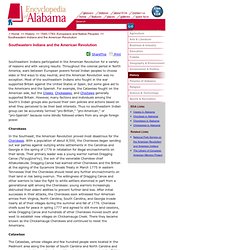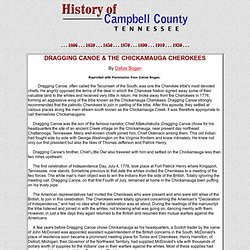

DRAGGING CANOE. Encyclopedia of Alabama: Southeastern Indians and the American Revolution. Southeastern Indians participated in the American Revolution for a variety of reasons and with varying results.

Throughout the colonial period in North America, wars between European powers forced Indian peoples to choose sides or find ways to stay neutral, and the American Revolution was no exception. Most of the southeastern Indians who fought in the war supported Britain against the United States or Spain, but some gave aid to the Americans and the Spanish.
For example, the Catawbas fought on the American side, but the Creeks, Chickasaws, and Choctaws generally supported Britain. However, many factions and individuals among the South's Indian groups also pursued their own policies and actions based on what they perceived to be their best interests. Thus no southeastern Indian group can be accurately termed "pro-British," "pro-American," or "pro-Spanish" because none blindly followed orders from any single foreign power. Cherokees Catawbas Creeks Choctaws Chickasaws Additional Resources. DRAGGING CANOE & THE CHICKAMAUGA CHEROKEES. By Dallas Bogan Reprinted with Permission from Dallas Bogan.

Dragging Canoe, often called the Tecumseh of the South, was one the Cherokee tribe's most devoted chiefs. He angrily opposed the terms of the deal in which the Cherokee Nation signed away some of their valuable land to the whites and received very little in return. He broke away from the Cherokees in 1776, forming an aggressive wing of the tribe known as the Chickamauga Cherokees. Dragging Canoe strongly recommended that the patriotic Cherokees to join in parting of the tribe. Dragging Canoe was the son of the famous narrator, Chief Attakullakulla. Dragging Canoe's brother, Chief Little Owl also traveled with him and settled on the Chickamauga less than two miles upstream. Cherokee - Forced From Their Homeland on the Trail of Tears. Evidence indicates that the Cherokee migrated in prehistoric times from present-day Texas or northern Mexico to the Great Lakes area.

However, wars with the Iroquois and Delaware tribes, who controlled those lands, pushed the Cherokee southeast to the mountains and valleys of the southern part of the Appalachian chain. They eventually settled in modern Virginia, West Virginia, North Carolina, Tennessee, Georgia, and Alabama. The Cherokee economy, like that of other Southeast tribes, was based primarily on agriculture, growing corn, beans, squash, sunflowers and tobacco. Deer, bear, and elk were hunted with bows and arrows. Smaller game, such as raccoons, rabbits, squirrels, and turkeys, were hunted with long cane-stem blowguns that propelled wood-and-feather darts.
Revolutionary War, Cherokee Defeat and Additional Land Cessions. By William L.

Anderson and Ruth Y. Wetmore, 2006. Additional research provided by John L. Bell. Part i: Overview; Part ii: Cherokee origins and first European contact; Part iii: Disease, destruction, and the loss of Cherokee land; Part iv: Revolutionary War, Cherokee defeat and additional land cessions; Part v: Trail of Tears and the creation of the Eastern Band of Cherokees; Part vi: Federal recognition and the fight for Cherokee rights; Part vii: Modern-day Cherokee life and culture; Part viii: References and additional resources Part iv: The Revolutionary War, Cherokee Defeat, and Additional Land Cessions Creek war scene with Indians defending their village against soldiers.
These attacks devastated the Cherokee people, who sued for peace, giving up huge parcels of land in the process. Indians and the American Revolution. Yet the passions engendered by the American Revolution, despite the good will expressed in the formal policy enunciated by the government, was to lead to bitter and violent confrontations on the frontier. The bloody ground of Kentucky was to be repeated in region after region as the undisciplined and unregulated expansion of the American people got underway.
In the end the Indian was the loser. That he would have been a loser even if the King had repressed the rebellion is probable; but his decline would not have been so swift or so bitter. 1. I have discussed the early English charters in my "Red Man's Land/White Man's Law: A Study of the Past and Present Status of the American Indian" (New York, 1971). 2. 3. 4. 5. Cherokee History.